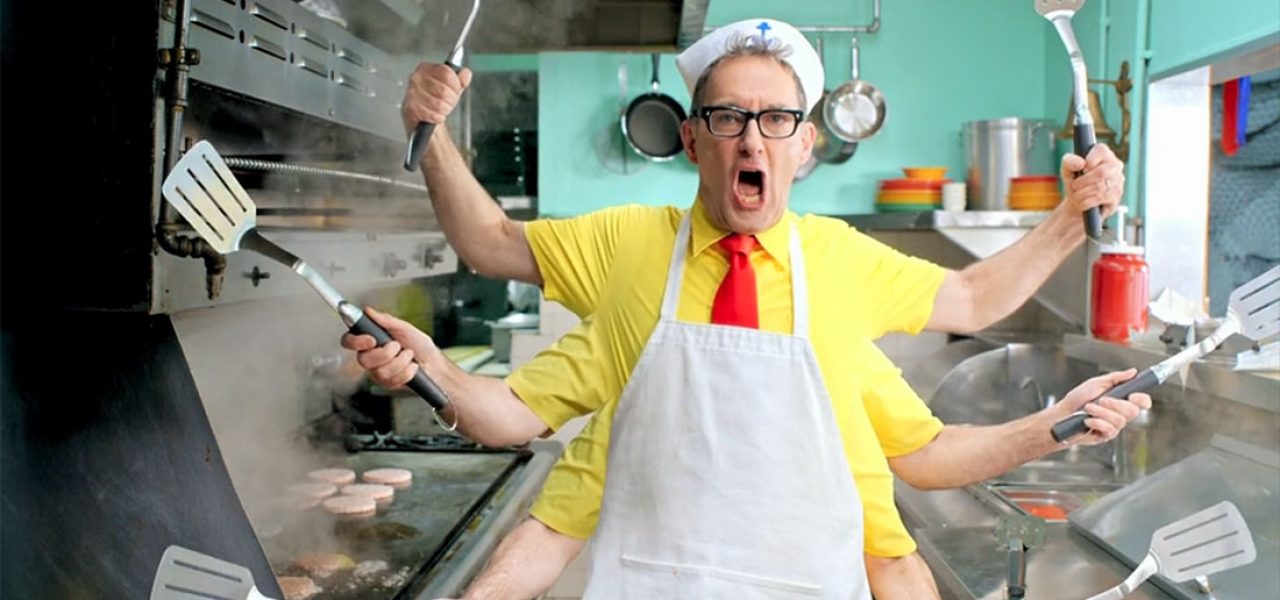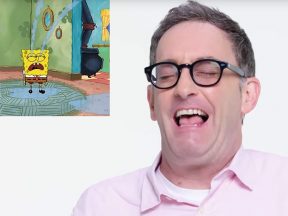

How Cartoons Met Their Own Voice Actors In ‘Spongebob’s Big Birthday Blowout’
Spongebob Squarepants is at a turning point. This year, the franchise celebrated its 20th anniversary, which was marked with, among other things, a one-hour tv special, Spongebob’s Big Birthday Blowout. Meanwhile, the series was renewed for a 13th season, and audiences were shown the trailer for The Spongebob Movie: Sponge on the Run — the character’s third theatrical outing, and the first to be predominantly cgi.
For the jaunty sponge and his aquatic friends, the future is secure. Yet it also contains unknowns, for this was the first year of the franchise since the death of its creator Stephen Hillenburg in November 2018. Although Spongebob’s Big Birthday Blowout was conceived before he died, it was subsequently recast as a tribute to him. The live-action director Jonas Morganstein, who studied at Calarts alongside Hillenburg, tells Cartoon Brew below about his efforts to honor the creator’s artistic spirit.
The special sees Spongebob (voiced by Tom Kenny) take a birthday tour of the live-action “surface world” with his best friend Patrick Star (Bill Fagerbakke). There, they encounter human versions of themselves, played by the voice cast (which, remarkably, has remained broadly unchanged throughout the show’s history). This surreal encounter — a first for the show — plays out in The Trusty Slab, the counterpart to the underwater burger joint frequented by the cartoon characters. Watch part of it below.
The special was well received when it aired on Nickelodeon in July, and has picked up an Annie nomination for best special production. Cartoon Brew caught up with Morganstein to discuss the joys and challenges of staging the hybrid scene in The Trusty Slab. He is joined by Hema Mulchandani, co-owner of the studio Jonas & Co., who served as executive producer on the special.
How did you direct the cast in this scene, particularly in terms of their physical performances?
Jonas Morganstein: This was an unprecedented situation: a group of actors who have been voicing characters for 20 years depicting a live-action “alternate reality” version of their characters for the first time ever.
When we’ve worked with Tom Kenny and Mr. Lawrence (Plankton) in the voiceover booth, you see them act out the lines physically: arms in air, animated faces. They bring the dialogue to life with their movements. Those pitch-perfect performances were already inside them.
We created the right set of parameters to nurture that performance. We built the perfect setting, founding a greasy spoon with the right layout of pass through window and grill and transforming it into The Trusty Slab. Next, we outfitted the cast in wardrobe that represented a real-world interpretation of each character. Then we rehearsed a few times with the entire cast, working out the blocking.

The live-action segments are full of cartoonish touches, like Kenny’s magnified eyes and multiple arms. How did you decide how far to push the cartooniness?
Morganstein: In the show, Spongebob is generally the only character that physically transforms. He’s the Tex Avery character whose emotional responses and reactions to physical situations are more powerful than can be contained within the simple sponge rectangle. My favorite nook of the Nickelodeon animation offices is the storyboarding team’s door, where the artists tape up their favorite Spongebob body transformations.
We needed the physical manifestation of Spongebob to express that same level of boundless personality that defies physical reality. So [his human counterpart] Jimbob dances in high speed, twirls the spatula like a propeller, and sprouts multiple arms like a Hindu god. These effects required over-the-top performances from Tom Kenny.
Were the live-action segments precisely storyboarded and scripted, or was there room for improvisation on set?
Hema Mulchandani: The entire episode was precisely boarded and scripted by the Nickelodeon Animation team. They came to us with all the story beats in place — especially for how the animated characters are integrated into each scene. Shots without character integration were open to improvisation.
Morganstein: There was a ton of improv, because it helped the actors lose themselves in their characters. Much of the horseplay between Tom and Clancy [Brown] in the kitchen was off book, especially as Tom teases Clancy — the ultimate intimidating straight guy next to Tom’s over-the-top performance. Bill and Roger [Bumpass] (as Patrick and Squidward) improvised vaudevillian banter, some of which made the final cut. And Mr. Lawrence used his writing skills as he explored variations in his robbery monologue.
What were the main challenges in compositing and editing this sequence?
Mulchandani: To hit the fast-paced schedule, a lot of the character animation had gotten started before the shoot. We had to be very precise with the live-action plates so it would seamlessly composite in post. For example, Spongebob jumping out of the tank to touch the spatula is a combination of multiple live-action plates, animated characters, cartoon water effects, cg elements, and smoke effects. The whole project needed to bounce back and forth between Nickelodeon Animation and us, because we worked on the scene in tandem. Multiply that times 407 shots.
The cartoon cast are replaced with figurines in some shots — I found this striking. Why this choice?
Mulchandani: Generally, the wide shots use figurines and the closeups use cartoon animations. It was both a time-saving device and a fun way to keep that indie DIY surreal vibe.
Did any hybrid films or series particularly inspire you in staging this scene?
Mulchandani: Spongebob showrunners Marc Ceccarelli and Vincent Waller encouraged us to watch the early 1980s avant-garde film Forbidden Zone as inspiration for the whole special. This cult classic [directed by Richard Elfman] is filled with mixed live action and animation, in-camera special effects, and fun low-budget solutions to tell an unconventional story. Marc and Vince would always encourage and challenge us to make sure we take creative risks and find mixed-media solutions.

Morganstein: That recommendation was liberating for us. You can see the film’s influence in the diner scene with its in-camera effects, speed ramps, and unabashed use of figurines. You can also see it in the office scene, especially the conference room with the monkey outfits and a dog puppet.
Plus this sensibility affected how we brought the segments with Patchy [the Pirate, played by Kenny] to life. For instance, when Patchy sails down the sidewalk like a boat. This was created in camera through human stop-motion pixilation inspired by Norman McLaren’s Neighbours, a film I loved back when I was at Calarts with Steve Hillenburg. I felt a personal responsibility to contribute artistry that reflects Steve’s artistic spirit, so these avant-garde film techniques seemed right on target.
If you look back at the Spongebob episodes for 20 years, the show has always embraced its live-action segments with a similar DIY sensibility that’s in tune with the animation’s comedic point of view. It’s all part of the joke.
(This interview was conducted by email, and has been lightly edited for brevity.)



